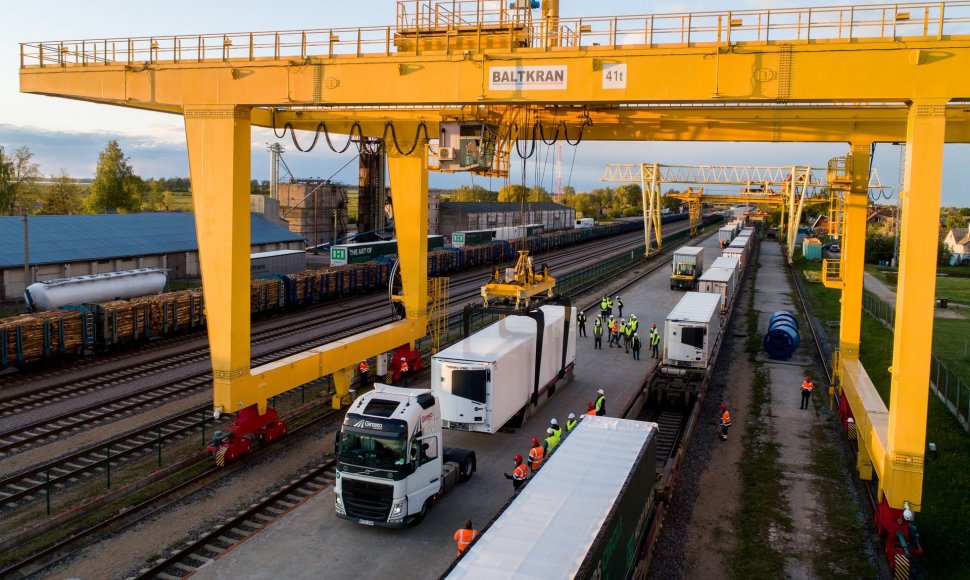According to Povlas Drižas, the secretary general of the International Transport and Logistics Alliance (TTLA), carrying freight by varied transport opens a wide range of opportunities for developing smart logistics centres and increasing the country’s competitive advantage in the international transportation market.
“Based on our information, the number of freight train trips will increase in the future and the geography of transporting lorry semitrailers will be expanded, encompassing the main European industrial and trade centres in Germany, France, Italy and the Netherlands. These markets are among the main ones that our country’s hauliers perform transportation operations and service export to,” P. Drižas says.
“The rail traffic plans for Rail Baltica outline that once the project is fully implemented, up to three freight trains will be able to travel on this line per hour between Kaunas, Warsaw, Rotterdam, Duisburg, and Milan, reaching a maximum speed of 120 kilometres per hour. It is planned for 80% of freight trains on the Rail Baltica line to be intermodal – offering opportunities for logistics operators to transfer freight from road transfer onto rail transport and carry containers and semitrailers by rail.
Hoptrans Logistics head Rimvydas Melkūnas says that the country’s convenient geographic location offers Lithuania exceptional opportunities for becoming a freight transit country, which serves European and Asian forwarding and logistics centres, which are distributed along the main land and maritime trade routes.
“Once the Rail Baltica railway is laid down past Kaunas, Lithuanian international transport and logistics companies will have access to yet another key corridor through the intermodal terminal, which will be connected directly to the European railway network. In this, I see vast potential for our country’s businesses to develop a powerful logistics chain, which would serve freight flows in the North-South and East-West directions,” R. Melkūnas says.
According to him, the Kaunas Intermodal Terminal will be operating at full capacity and so, it will strengthen the country’s entire transport and logistics infrastructure, which is one of the country’s main economic foundations.
“Extra freight transport routes create added value to businesses, clients, consumers, and the state. Everyone benefits from this because the implementation of sustainable business solutions and ensuring logistics capacities will create added value and jobs for Lithuanian industry in terms of both exports and imports,” R. Melkūnas says.
Businesses view Kaunas as a key centre, which will see forwarding and distribution of cargo between Europe, Scandinavia, the CIS, and Asia. The Kaunas Intermodal Terminal is placed in a convenient location, between the country’s main highways of Vilnius-Kaunas-Klaipėda and Via Baltica. Logistics companies are settling around the location, the Kaunas Free Economic Zone is established nearby, and Kaunas Airport and Klaipėda Seaport are both within convenient reach.
Organising the rail transportation of semitrailers is nothing new for the Klaipėda-based company Vlantana. The company has been making use of this means of transporting semitrailers for a decade now in Western Europe. Vladas Stončius, the head of Vlantana, explains that the company is interested in opportunities for transporting semitrailers by train on long routes and using lorries for last-mile logistics. According to him, if intermodal transportation is performed over more than 150km, heavier loads are permitted on the semitrailer than if it were to travel by road alone.
“Such combined freight transportation allows companies to have more semitrailers than trucks, save on fuel, and reduce CO2 emissions. Furthermore, transporting semitrailers by rail also partially resolves the problem of a lack of drivers,” V. Stončius says. Currently, the company’s semitrailers typically travel by rail between the Benelux countries, Spain, Italy, Germany, and Poland.
“These are the main markets where the largest international freight transportation operations are performed. Furthermore, the Scandinavian countries can be reached from Klaipėda Seaport by ferry. Thus, we currently transport around a third of our freight volumes namely by Western European railways and ferry lines,” V. Stončius says.
When freight is transported by rail, CO2 emissions are threefold lower than if road transportation were used. Around 25 million tonnes of freight are transported between Lithuania and Poland every year, but only around 2% of it by rail, while the two states’ border sees around 2.5 million lorries crossing every year.















